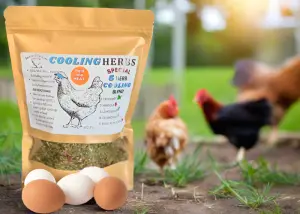
It can seem like an eternity waiting for your hen to lay her first egg! Luckily, there are some tell-tale signs to look for that will help answer one of the most asked questions of chicken owners, “When do hens start laying eggs?”

🌿 Encourage Laying with Nesting Box Herbs

Nesting Box Herbs
- Increases egg laying naturally.
- Improves chicken health.
- Deters parasites: mites, lice, fleas & flies as well as mice, rats, raccoons, coyotes, opossums and more!
- On SALE!
- SHOP Nesting Box Herbs
If your hen is showing several of the signs listed above, she’s likely getting close to laying her first egg. This is the perfect time to prepare her nesting space and encourage her to lay where you want her to — in the nesting box!
One easy and natural way to do that is by sprinkling a small handful of our Nesting Box Herbs into each box. These herbs create a cozy, calming, and inviting space that hens love.

🪶 Benefits of Using Nesting Box Herbs:
- Encourages hens to lay in the right spot by creating a soft, fragrant, and soothing environment
- Calms anxious or nervous pullets who are new to the laying process
- Naturally repels mites and insects, keeping your nesting area clean and pest-free
- Supports respiratory health with aromatic herbs like peppermint and rosemary
- Reduces nesting box odor with antibacterial and antifungal properties
- Stimulates interest in nesting boxes, especially for pullets who are visiting them frequently but haven’t laid yet
- Promotes overall wellness, which is essential during the transition to egg-laying
I’ve found that pullets will often nestle into freshly sprinkled herbs and even fall asleep in the box while they’re preparing to lay — it becomes their safe, happy place!
7 Signs Your Hens are Getting Close to Laying
1. Pelvic Bones Separated
In order for a hen to be able to physically lay an egg, its pelvic bones must be separated enough to allow an egg to pass through it.
As a hen grows, her pelvic bones will slowly separate.
How to Check a Hens Pelvic Bone Gap
STEP 1: Locate the hens vent.
STEP 2: Place a flat hand, finger side facing down, directly above the vent.
STEP 3: With your fingers, feel for the pointy parts of your hens pelvic bones. You should feel them on both sides, slightly above the vent.
STEP 4: How many of your fingers can you fit between the two pelvic bones?
Reading Hen Pelvic Bone Gap Results
| FINGER DISTANCE BETWEEN PELVIC BONES | IS YOUR HEN READY TO START LAYING EGGS? |
|---|---|
| 1 FINGER | YOUR HEN IS TOO YOUNG OR NOT READY FOR EGG LAYING. |
| 2 FINGERS | SMALLER BREEDS CAN BE LAYING. REGULAR BREEDS MAY BE LAYING |
| 3-4 FINGERS | DEFINITELY LAYING AND CAPABLE OF PRODUCING LARGE EGGS |
2. Hen is at Least 16 Weeks Old
A hen must be sexually mature in order to be able to produce an egg. The average age that a chicken is sexually mature and able to produce eggs is between 16-24 weeks.
Different breeds mature at different times.
Do All Breeds Start Laying Around the Same Time?
Not all chicken breeds will begin laying at the same time. Most hens will begin laying between 16-24 weeks, but others are may begin much later. Silkies develop much slower and are not sexually mature until much later. The average age that a silkie chicken will begin laying eggs is around 8 months of age.
3. Comb and Wattle Turn a Deep Red Color
When a healthy hen becomes sexually mature, it begins to have increased blood circulation to its comb and wattle. The once pale, pink comb and wattle will gradually turn a beautiful, bright red color.
A rosy red comb and wattle signifies that your hen is sexually mature and getting ready for egg laying.
4. The Submissive Squat of Point of Lay Hens
What does it mean if my hen squats?
When a hen reaches sexual maturity and is ready to lay, she will do what is called, a “submissive squat.” She will squat down, flatten her back, spread her wings to the side and lower her tail when approached by a rooster. This is a signal to him that she is receptive to mating.
Squatting down, flattening her back and lowering her tail feathers makes it easier for the rooster to jump up on her back to mate.
A hen will spread her wing feathers out to keep balance while the rooster is “treading” on her back.
It isn’t uncommon to also see a hen lower in the pecking order do a submissive squat when approached by a hen higher up in the pecking order.
This squatting instinct is so strong, that in the absence of a rooster, a hen approaching laying age may squat when a human approaches it. If this happens, expect her to start laying eggs within the week!
5. Frequent Visits to the Nesting Box
A hen instinctively knows when its body is getting ready to start laying eggs. She will seek out a soft, quiet, dark place to lay her egg.
Try to make your nesting boxes as inviting as possible. Some people will even dress them up by installing privacy curtains and sprinkling egg laying herbs in the nesting box to encourage egg laying!
Tips to Encourage Egg Laying in the Nesting Box
| TIPS TO ENCOURAGE EGG LAYING IN THE NESTING BOX |
|---|
| 1. ADD DRIED EGG LAYING HERBS TO THE NESTING BOXES |
| 2. PROVIDE THE RIGHT NUMBER OF BOXES |
| 3. PROVIDE THE RIGHT SIZE BOXES |
| 4. PUT THEM IN A QUIET LOCATION |
| 5. NESTING BOXES SHOULD BE IN A DARK LOCATION |
| 6. NESTING BOXES SHOULD BE AT THE RIGHT LEVEL |
| 7. PROVIDE NESTING MATERIAL |
| 8. ADD PRIVACY CURTAINS |
| 9. CLEAN THE NESTING BOXES REGULARLY |
| 10. HAVE NESTING BOXES AVAILABLE BY 16 WEEKS OF AGE |
| 11. KEEP THE COOP COOL |
| 12. BLOCK OFF UNWANTED LAYING AREAS |
| 13. ADD FAKE EGGS TO NESTING BOXES |
| 14. KEEP HENS LOCKED IN COOP UNTIL AFTERNOON |
6. Hen Shows Interest in Oyster Shells
A hen that is working on producing eggs needs 4 times the amount of calcium! Laying hens require 4-5 grams of calcium each day in order to produce the optimum amount of eggs.
Do I Have to Provide Oyster Shells for My Laying Hens?
Laying hens need to be provided with increased calcium, such as oyster shells or crushed egg shells for a variety of reasons:
- Hens that are provided with the proper amount of calcium in their diet will produce the optimum amount of eggs for their breed as well as larger eggs with thicker shells.
- A lack of calcium in a hens diet can lead to the production of less eggs with thinner egg shells.
- It can also cause hens to develop softening of their bones and rickets.
- This is why it is important to introduce oyster shell to your hens as they approach laying age.

A chicken instinctively knows what its body needs (or may be lacking) and will seek out foods that contain that substance.
Offer oyster shell separate from the chicken feed. Your hens will only eat as much as its body requires. If you mix the oyster shell in with chicken feed, your hens may accidentally get too much calcium.
Once you begin to see your hens eating from the oyster shell station, you can expect to see eggs from them very soon!
7. Changes in a Hens Vent
A hen that is not laying will have a smaller, round shaped vent opening that is dry and pale. As a hen approaches point of lay the vent will become larger, oval shaped, moist and pink.
Differences Between a Non-Laying Hens Vent vs. a Laying Hens Vent
| VENT CHARACTERISTICS OF NON-LAYING HENS | VENT CHARACTERISTICS OF LAYING HENS |
|---|---|
| DRY | MOIST |
| PALE | PINK |
| SMALL | LARGER |
| ROUND | OVAL |
CONCLUSION: When do Hens Start Laying Eggs? 7 Important Signs

🥚 Final Thoughts: Spot the Signs & Support Your Future Layers
Watching for the 7 tell-tale signs that your hens are ready to lay — from red combs and wattle to submissive squats and curiosity about the nesting box — can help you prepare for that exciting first egg. It’s a rewarding moment when all your care and patience finally pay off.
To help your hens make a smooth transition into laying, take a proactive step:
Sprinkle our Nesting Box Herbs into each box to create an inviting, clean, and calm space they’ll want to return to again and again.
With the right signs in place — and the right environment in the nesting box — your hens will be well on their way to becoming consistent, happy layers.








